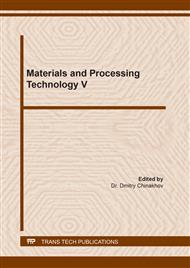[1]
Kuznetsov M.A., Danilov V.I., Krampit M.A., Chinakhov D.A., Slobodyan M.S. Mechanical and tribological properties of a metal wall grown by an electric arc method in a protective gas environment. Obrabotka metallov (Metal working and material science). 2020. 22 (3) Pp. 18–32.
DOI: 10.17212/1994-6309-2020-22.3-18-32
Google Scholar
[2]
Sing S.L., An J., Yeong W.Y., Wiria F.E. Laser and electron-beam powder-bed additive manufacturing of metallic implants: A review on processes, materials and designs. Journal of Orthopaedic Research, 2016, vol. 34, iss. 3, p.369–385.
DOI: 10.1002/jor.23075
Google Scholar
[3]
Murr L.E., Gaytan S.M., Ramirez D.A., Martine, E., Hernandez J., Amato K.N., Shindo P.W., Medina F.R., Wicker R.B. Metal fabrication by additive manufacturing using laser and electron beam melting technologies. Journal of Materials Science and Technology, 2012, vol. 28, iss. 1, p.1–14.
DOI: 10.1016/s1005-0302(12)60016-4
Google Scholar
[4]
Gu D.D., Meiners W., Wissenbach K., Poprawe R. Laser additive manufacturing of metallic components: materials, processes and mechanisms. International Materials Reviews, 2012, vol. 57, iss. 3, p.133–164.
DOI: 10.1179/1743280411y.0000000014
Google Scholar
[5]
Elmer J. W., Gibbs G. The effect of atmosphere on the composition of wire arc additive manufactured metal components. Science and Technology of Welding and Joining, 2019, vol. 24, iss. 5, p.367–374.
DOI: 10.1080/13621718.2019.1605473
Google Scholar
[6]
Lu T., Liu C., Li Z., Wu Q., Wang J., Xu T., Liu J., Wang H., Ma S. Hot-wire arc additive manufacturing Ti-6.5Al-2Zr-1Mo-1V titanium alloy: pore characterization, microstructural evolution, and mechanical properties. Journal of Alloys and Compounds, 2020, vol. 817, no. 153334.
DOI: 10.1016/j.jallcom.2019.153334
Google Scholar
[7]
Rodriguez N., Vázquez L., Huarte I., Arruti E., Tabernero I., Alvarez P. Wire and arc additive manufacturing: a comparison between CMT and TopTIG processes applied to stainless steel. Welding in the World, 2018, vol. 62, p.1083–1096.
DOI: 10.1007/s40194-018-0606-6
Google Scholar
[8]
Chinakhov D.A., Akimov K.O., Dubrovskiy A.S., Ilyaschenko D.P. Influence of Thermal Limiters on the Formation of the Dendritic Structure of the Welded Stainless Steel Layer. Journal of Physics: Conference Series 1945 (2021) 012038.
DOI: 10.1088/1742-6596/1945/1/012038
Google Scholar
[9]
Queguineur A., Rückert G., Cortial F., Hascoët J.Y. Evaluation of wire arc additive manufacturing for large-sized components in naval applications. Welding in the World, 2018, vol. 62, iss. 2, p.259–266.
DOI: 10.1007/s40194-017-0536-8
Google Scholar
[10]
Bekker A. C. M., Verlinden J. C. Life cycle assessment of wire + arc additive manufacturing compared to green sand casting and CNC milling in stainless steel. Journal of Cleaner Production, 2018, vol. 177, p.438–447.
DOI: 10.1016/j.jclepro.2017.12.148
Google Scholar
[11]
Zhai, Y., Lados D.A., LaGoy J.L. Additive Manufacturing: Making Imagination the Major Limitation. JOM. 2014. 66. p.808–816.
DOI: 10.1007/s11837-014-0886-2
Google Scholar
[12]
Laser and electron-beam powder-bed additive manufacturing of metallic implants: A review on processes, materials and designs / S.L. Sing et al. // J. Orthop. Res. 2015. 34. p.369–385.
DOI: 10.1002/jor.23075
Google Scholar
[13]
Laser powder-bed fusion additive manufacturing: Physics of complex melt flow and formation mechanisms of pores, spatter, and denudation zones / S.A. Khairallah et al. // Acta Mater. 2016. 108. p.36–45.
DOI: 10.1016/j.actamat.2016.02.014
Google Scholar
[14]
Karayel E., Bozkurt Y. Additive manufacturing method and different welding applications. Journal of Materials Research and Technology. 2020. Vol. 9, 5. pp.11424-11438.
DOI: 10.1016/j.jmrt.2020.08.039
Google Scholar
[15]
A review of the wire arc additive manufacturing of metals: Properties, defects and quality improvement/ B. J. Wu et al. // Manuf. Process. 2018. 35. p.127–139.
Google Scholar
[16]
Influence of hardness on the wear resistance of 17-4 PH stainless steel evaluated by the pin-on-disc testing / J. Bressan et al. // J. Mater. Process. Technol. 2008. Vol.205, Iss. 1-3. p.353–359.
DOI: 10.1016/j.jmatprotec.2007.11.251
Google Scholar
[17]
SТP 26.260.486-2005. Catalog of analogues of imported and domestic basic and welding materials used in the manufacture of vessels, apparatus and pipelines subordinate to Rostekhnadzor. Introduced 2008-08-29. Volgograd. 49 p.
Google Scholar
[18]
STAINLESS STEEL TECHNICAL HANDBOOK. ESAB [electronic resource]. Access mode: www.url: https://www.alas-kuul.ee/media/wysiwyg/CMS/Stainless%20handbook.pdf. 09.07.(2021).
Google Scholar
[19]
Metallurgie und Werkstofftechnik: e. Wissensspeicher. 2 Bände R. Zimmermann, K. Günther. (1977).
Google Scholar


